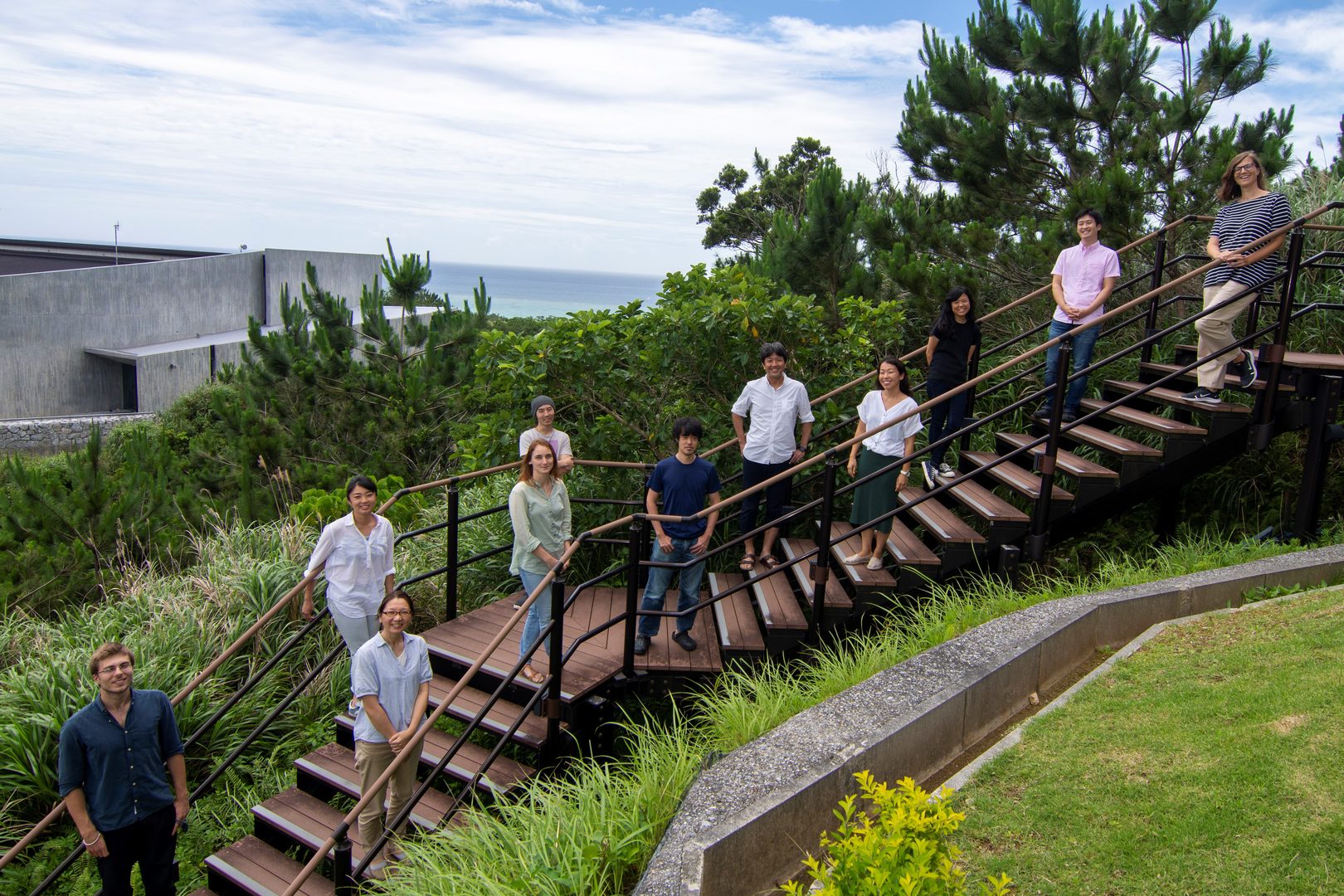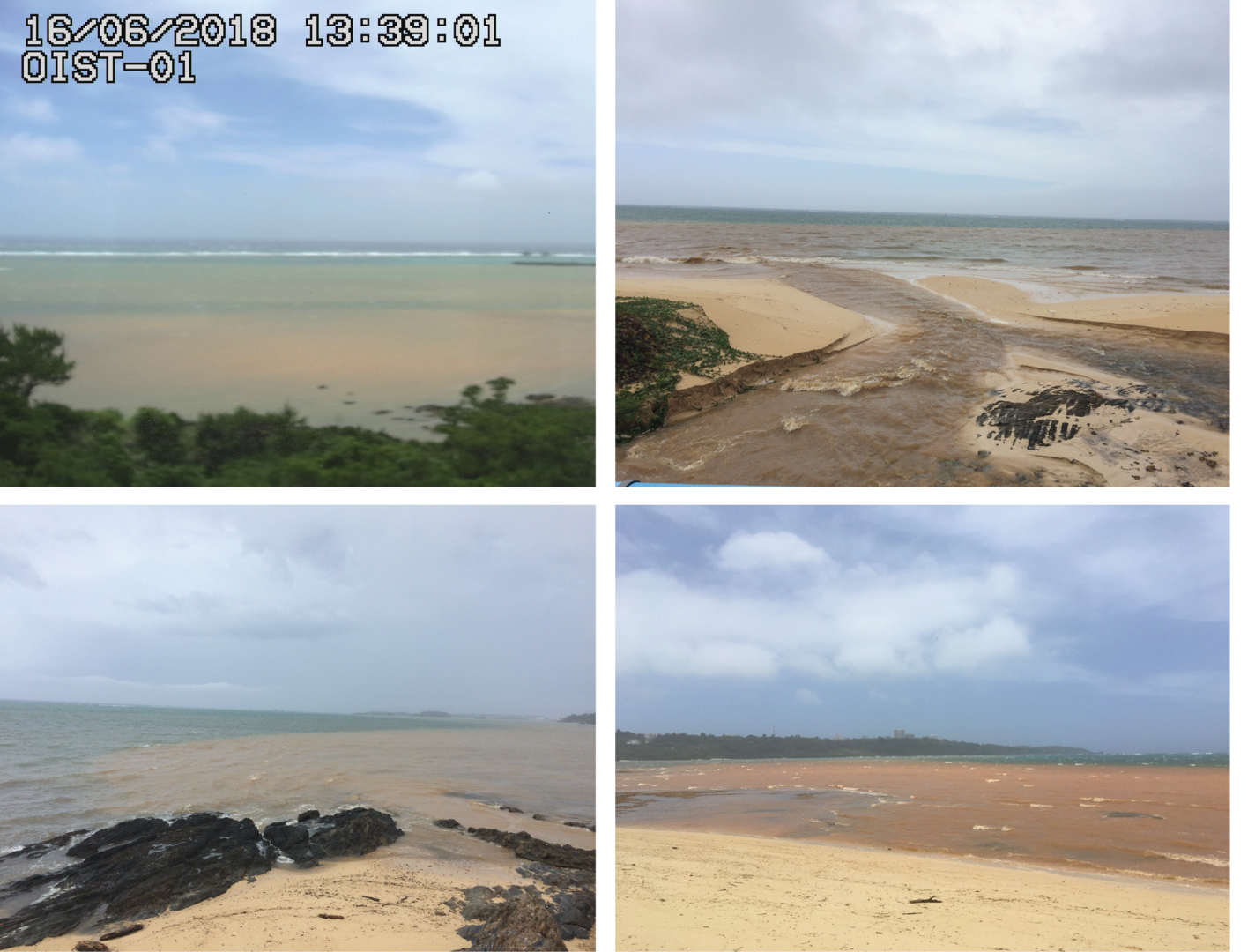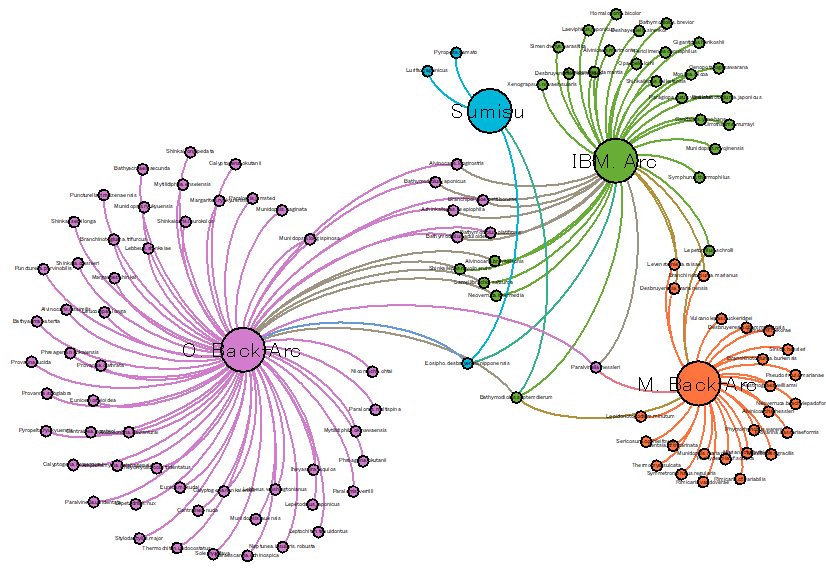FY2019 Annual Report
Marine Biophysics Unit
Associate Professor Satoshi Mitarai

Abstract
Marine Biophysics Unit will develop forecasting system for the coastal ocean circulation processes around Okinawa and implement a validated connectivity assessment tool, coupling available modeling and observation techniques. This modeling tool will help marine biologists and genetics estimate rates of geneticists estimate rates of gene flow among sites, enable public agencies to build and evaluate marine protected areas based on population connectivity, and provide marine ecologists with a modeling system for predicting the global and long-term dynamics of the marine ecosystem. Marine Biophysics Unit was established on Sep. 1, 2009 when Satoshi Mitarai joined OIST.
1. Staff
- Satoshi Mitarai, (September 2009 –)
- Yuichi Nakajima, Staff Scientist (August 2013 –)
- Angela Ares Pita, Postdoctoral Scholar (August 2017 –)
- Marine Le Gal, Postdoctoral Scholar (September 2017 –)
- Kirk Sato, Postdoctoral Scholar (September 2017 – June 2019)
- Heng Wu, Postdoctoral Scholar (July 2019 –)
- Yosuke Yamada, Postdoctoral Scholar (September 2019 –)
- Kazumi Inoha, Research Assistant (April 2015 –)
- Otis Brunner, Graduate Student (April 2017 –)
- Maki Thomas, Graduate Student (September 2015 –)
- Margaret Mars Brisbin, Graduate Student (September 2015 –)
- Po-Shun Chuang, Graduate Student (September 2015 –)
- Juan Fernando Carrascal Tristancho, Graduate Student (January 2018 – April 2019)
- Shubham Gautam, Graduate Student (May 2019 – August 2019)
- Kota Ishikawa, Graduate Student (September 2019 – December 2019)
- Asa Conover, Research Intern (January 2019 – June 2019)
- Noam Vogt-Vincent, Research Intern (July 2019 – September 2019)
- Tomoko Yoshino, Research Unit Administrator (March 2019 –)
2. Collaborations
2.1 Larval dispersal of coral reef species
- Type of collaboration: Joint research
- Researchers:
- Prof. K. Sakai, University of the Ryukyus
- Prof. M. Nakamura, Tokai University
2.2 Okinawa coastal ocean observing system
- Type of collaboration: Joint research
- Researchers:
- Okinawa Prefectural Fisheries Research and Extension Center
- 11th Japan Regional Coast Guard
2.3 Coral ecosystem diversity and spatial distribution throughout the islands of Okinawa
- Type of collaboration: Joint research
- Researchers:
- The Regents of the University of California, UC San Diego’s Scripps Institution of Oceanography
3. Activities and Findings
3.1 Extreme storms cause rapid, context-dependent shifts in nearshore subtropical bacterial communities
Climate change scenarios predict tropical cyclones will increase in both frequency and intensity, which will escalate the amount of terrestrial run-off and mechanical disruption affecting coastal ecosystems. Bacteria are key contributors to ecosystem functioning, but relatively little is known about how they respond to extreme storm events, particularly in nearshore subtropical regions. In this study, we combine field observations and mesocosm experiments to assess bacterial community dynamics and changes in physicochemical properties during early- and late-season tropical cyclones affecting Okinawa, Japan. Storms caused large and fast influxes of freshwater and terrestrial sediment—locally known as red soil pollution—and caused moderate increases of macronutrients—especially SiO2 and PO43-. We detected shifts in relative abundances of marine bacteria and the introduction of terrestrially-derived bacteria, including putative coral and human pathogens, during storm events. Soil input alone did not substantially affect marine bacterial communities in mesocosms, indicating that other components of run-off or other storm effects likely exert a larger influence on bacterial communities. The storm effects were short-lived and bacterial communities quickly recovered following both storm events. The early- and late-season storms caused different physicochemical and bacterial community changes, demonstrating the context-dependency of extreme storm responses in a subtropical coastal ecosystem.

Figure 1: Photographs showing the red soil run-off after the tropical storm Gaemi the 16th of June of 2018. Photographs were taken within a 10 km radius of the study area between 13:00 and 15:30 pm, just 2–3 hours after the peak of rain.
3.2 Relationship between genotypes and phenotypes of Galaxea corals in the Ryukyu Archipelago
Galaxea is a genus of hermaphroditic corals that are mainly distributed in the tropical coastal areas of the Indo-West PaciHc region. It is possible to increase the number of clones of these corals by asexual reproduction. Galaxea corals in the Ryukyu Archipelago are classiHed into at least three types, based on their mitochondrial DNA (mtDNA); however, the mechanism of population maintenance in these corals is not clear as yet. In this study, we elucidated as to how Galaxea corals maintain their local populations, focusing on inter- and intraspeciHc genotypes, morphs, germ cells, and sex. We collected branches from 289 colonies of Galaxea corals at four sites (Amami, Okinawa, Miyako, and Iriomote) in the Ryukyu Archipelago. We recorded the location of these colonies with respect to their GPS coordinates and took a photograph for each colony. Histological examinations were done on branches collected from Okinawa. After the extraction of DNA from the branches, fragment analysis was performed using 15 microsatellite and one mtDNA (nad2–cytb) loci. The branches used for histological examination were Hxed and decalciHed using Bouin’s solution and were stained with hematoxylin and eosin; the sex was determined by observation of the germ cells in the gonad using a microscope. At all sites, except for Amami, we found clonal colonies, and the genotype distribution was locally biased by fragmentation. All clonal colonies with the same genotype showed the same colored morph. In addition, the histological observations showed a biased sex ratio between the different mtDNA types. All clonemates had the same sex, and therefore, the sex could be determined by the genotype. In case there are fewer colonies from sexual reproduction and the sex ratio is biased, the released larvae are extremely fewer in number and might not contribute to the larval supply to other reef sites.
3.3 Numerical modeling of the 1771 tsunami to better understand the effect of the reef during the event.
Numerical modeling is a powerful tool that can help us to better understand phenomena that are difficult to reproduce in laboratory such as tsunamis. During the 1771 tsunami event, half of the Ishigaki population was lost. Extreme run-ups and inundations were observed and have been estimated from geological evidence. For storms and regular swells, it has previously been estimated that 80% of the wave energy is taken by the reef. However, for tsunami events, the effect of the reef is more mitigated and could even amplify the inundation instead of protecting the coast. Only a few studies had been performed on historical tsunamis and we aimed to quantitatively estimate the reef effect for this particular tsunami event. To reach this goal, a few numerical models of the event were built using Shallow Water models. For each model, characteristics of the reef were modified revealing their impact. From these numerical results, a new indicator, the Reef Impact Factor, was defined, revealing that wave heights were reduced by around 12% with the reef. It also showed a great dependance on the wave shape and the presence of channels in the reef which amplified the inundation. This point is crucial when considering the impact of modification of reefs and when considering coastal management.

Figure 3: Propagation and evolution of the modeled waves during the 1771 tsunami event.
3.4 Hydrothermal Vents of the North-West Pacific: Detecting metacommunity structures using network theory.
Hydrothermal vent fields are discrete ‘oases’ of high biological productivity in the deep sea. Local communities of vent-endemic species are spatially isolated but demographically linked through larval dispersal forming multi-vent metacommunities. The purpose of this study is to establish the presence of distinct hydrothermal vent metacommunities within the North-West Pacific Bioregion using network theory. The resultant presence of multiple distinct and spatially overlapping metacommunities within the same region highlights the interplay between local and regional drivers of vent-endemic community composition. Local environmental differences between vents driven by their tectonic setting (Arc vs Back-arc) differentiates spatially overlapping communities in the Mariana Region. While regional dispersal barriers may explain the distinctness of the Okinawa Back-arc communities from the rest of the region. The principle advantage of this application of network theory over traditional community clustering is the ability to investigate the role each local vent community plays in the regional metacommunity structure. We demonstrate how these results can aid stakeholders in prioritizing vent sites for spatial management. Such evaluations are of particular urgency in the age of deep-sea mining, where the effective removal of a vent community will have unknown impacts on the larger metacommunity.

Figure 4: Bipartite Community Assemblage Network coloured by modularity measure of community groupings. Small nodes represent species and large nodes represent a collection of hydrothermal vents of the same module grouping. Module grouping is determined by the amount of shared species between vents. Lines represent the presence of a named species at a vent within the module groups.
4. Publications
4.1 Journals
-
Price, N. N., Muko, S., Legendre, L., Steneck, R., van Oppen, M. J. H., Albright, R., Ang Jr., P., Carpenter, R. C., Chui, A. P. Y., Fan, T.-Y., Gates, R. D., Harii, S., Kitano, H., Kurihara, H., Mitarai, S., Padilla-Gamiño, J. L., Sakai, K., Suzuki, G., Edmunds, P. J. Global biogeography of coral recruitment:tropical decline and subtropical increase. Marine Ecology Progress Series, doi:doi: 10.3354/meps12980 (2019)
-
Wepfer, P.H., Nakajima, Y., Hui, F. K. C., Mitarai, S., Economo, E. P. Metacommunity ecology of Symbiodiniaceae hosted by the coral Galaxea fascicularis. Marine Ecology Progress Series, doi: doi: 10.3354/meps13177 (2020).
-
Boquete, M.T, Ares, A., Fernández, J.A., Aboal, J.R., Matching times: Trying to improve the correlation between heavy metal levels in mosses and bulk deposition, Science of The Total Environment, doi: doi: 10.1016/j.scitotenv.2020.136955 (2020).
-
Ares, A*., Brisbin. M. M*., Sato, K.N, Martin J.P., Iinuma, Y., Mitarai, S., Extreme storm-induced run-off causes rapid, context-dependent shifts in nearshore subtropical bacterial communities, BioRxiv preprint,; doi: doi: 10.1101/801886 * These authors contributed equally.
4.2 Books and other one-time publications
Nothing to report
4.3 Oral and Poster Presentations
-
Nakajima, Y., Wepfer, P. H., Mitarai, S. Relationship between genotypes and phenotypes of Galaxea corals in the Ryukyu Archipelago, the 56th Annual Meeting of the Biological Society of Okinawa, Okinawa, Japan, 2019.05.25.
-
Brunner, O., Hydrothermal Vent Metacommunity Networks: A PhD Thesis Designed at a New and Unique University, Marine Biology and Ecology Research Centre (MBERC) Seminar Series, Plymouth University, Plymouth, UK, 2019.07.24.
-
Ares, A., Nunoura, T., Sakai, S., Brisbin, M. M., Sasaki, T., Mitarai, S. Differential responses of deep-sea hydrothermal vent Epsilonproteobacteria to heavy metals in a laboratory experiment, the 25th Annual Meeting of Japanese Society of Environmental Toxicology, National Institute of Environmental Sciences, Tsukuba, Japan, 2019.09.25-26. * Best Poster Award
-
Chuang, PS., Mitarai, S., Transcriptome analysis reveals parallel mechanisms in hyperosmosis-induced polyp bail-out, the 22nd Annual Meeting of the Japanese Coral Reef Society, Hokkaido University, Sapporo, Japan, 2019.11.09.
-
Nakajima, Y., Wepfer, P.H., Mitarai, S., Spatial genetic structure and phenotypes of Galaxea corals in the Ryukyu Archipelago, the 22nd Annual Meeting of the Japanese Coral Reef Society, Hokkaido University, Sapporo, Japan, 2019.11.09.
-
Ares, A., Plankton community dynamics under red soil pollution in nearshore waters. the 4th Okinawa Marine Science Workshop, OIST, Okinawa, Japan, 2019.12.06.
-
Brunner, O., University Marine Initiative (UMI): Science outreach for community engagement, the 4th Okinawa Marine Science Workshop, OIST, Okinawa, Japan, 2019.12.06.
-
Le Gal, M., Mitarai, S., Numerical modeling of the 1771 Yaeyama Tsunami and influence of the reef on the inundation, the 4th Okinawa Marine Science Workshop, OIST, Okinawa, Japan, 2019.12.06.
-
Thomas, M., Nakajima, Y., Mitarai, S., Landscape Genetic Method and Oceanographic Method to Explain Intra- and Inter-Island Propagule Transport of Mangrove Species in Okinawa Islands, the 4th Okinawa Marine Science Workshop, OIST, Okinawa, Japan, 2019.12.06.
-
Nakajima, Y., Wepfer, P.H., Mitarai, S., Spatial genetic structure and phenotypes of Galaxea corals in the Ryukyu Archipelago, the 4th Okinawa Marine Science Workshop, OIST, Okinawa, Japan, 2019.12.06.
-
Brisbin, M.M., Mitarai, S., Single-Cell Transcriptome Profiling Reveals Mechanisms of Host-Control and Nutrient Exchange in Acantharia-Phaeocystis Photosymbioses, Ocean Sciences Meeting 2020, San Diego Convention Center, San Diego, US, 2020.02.18.
-
Yamada, Y., Petel, N., Azam, F., Bacterial Surface Roughness Affects Viral Attachment in Seawater, Ocean Sciences Meeting 2020, San Diego Convention Center, San Diego, US, 2020.02.18.
-
Ares, A., Brisbin, M. M., Sato, K., Diaz, J.P.M., Iinuma, Y., Mitarai, S., Prokaryote Community and Physicochemical Shifts due to Storm Induced Terrestrial Runoff in Subtropical Coastal Ecosystems, Ocean Sciences Meeting 2020, San Diego Convention Center, San Diego, US, 2020.02.19.
-
Le Gal, M., Numerical models of the 1771 Meiwa tsunami to better understand tsunami-reef interactions, the 4th KOZWaves Conference, The University of Melbourne, Melbourne, Australia, 2020.02.19.
-
Nakajima, Y., Wepfer, P.H., Mitarai, S., Spatial genetic structure and phenotypes of Galaxea corals in the Ryukyu Archipelago, Ocean Sciences Meeting 2020, San Diego Convention Center, San Diego, US, 2020.02.20.
-
Thomas, M., Nakajima, Y., Mitarai, S. Landscape Genetic Method to Explain Intra- and Inter-Island Propagule Transport of Mangrove Species in Okinawa Islands, Ocean Sciences Meeting 2020, San Diego Convention Center, San Diego, US, 2020.02.21.
-
Le Gal, M., Are the reef efficient tsunami protection? Researcher Appreciate Week (RAW!), OIST, Okinawa, Japan, 2020.03.02.
-
Nakajima, Y., Wepfer, P.H., Mitarai, S., The relationship between genotypes and phenotypes of Galaxea corals in the Ryukyu Archipelago, the 67th Annual Meeting of Ecological Society of Japan, Meijo University, Nagoya, Japan, 2020.03.05 (cancelled due to COVID-19).
-
Thomas, M., Nakajima, Y., Mitarai, S., Landscape Genetic Method to Explain Intra- and Inter-Island Propagule Transport of Mangrove Species in Okinawa Islands, the 67th Annual Meeting of Ecological Society of Japan, Meijo University, Nagoya, Japan, 2020.03.05 (cancelled due to COVID-19).
-
Brunner, O., Suzuki, Y., Mitarai, S., Economo, E., Hydrothermal Vent Metacommunity Networks of the North-West Pacific, the 67th Annual Meeting of Ecological Society of Japan, Meijo University, Nagoya, Japan, 2020.03.05 (cancelled due to COVID-19).
-
Le Gal, M., Mitarai, S., Numerical modeling of the 1771 Yaeyama Tsunami and influence of the reef on the inundation, Researcher Appreciate Week (RAW!), OIST, Okinawa, Japan, 2020.03.05.
-
Brisbin, M.M., Mitarai, S., Single-Cell Transcriptome Profiling Reveals Mechanisms of Host-Control and Nutrient Exchange in Acantharia-Phaeocystis Photosymbioses, Researcher Appreciate Week (RAW!), OIST, Okinawa, Japan, 2020.03.05.
5. Intellectual Property Rights and Other Specific Achievements
Nothing to report
6. Meetings and Events
6.1 Subtropical Reef and Watershed Complexes Through Time: the little things that rule the world
- Date: June 12, 2019
- Venue: OIST Campus B503
- Speaker: Dr. John B. Sculley (University of California, Berkeley and the National Tropical Botanical Gardens, Kalaheo, Hawaii)
7. Other
Nothing to report.



